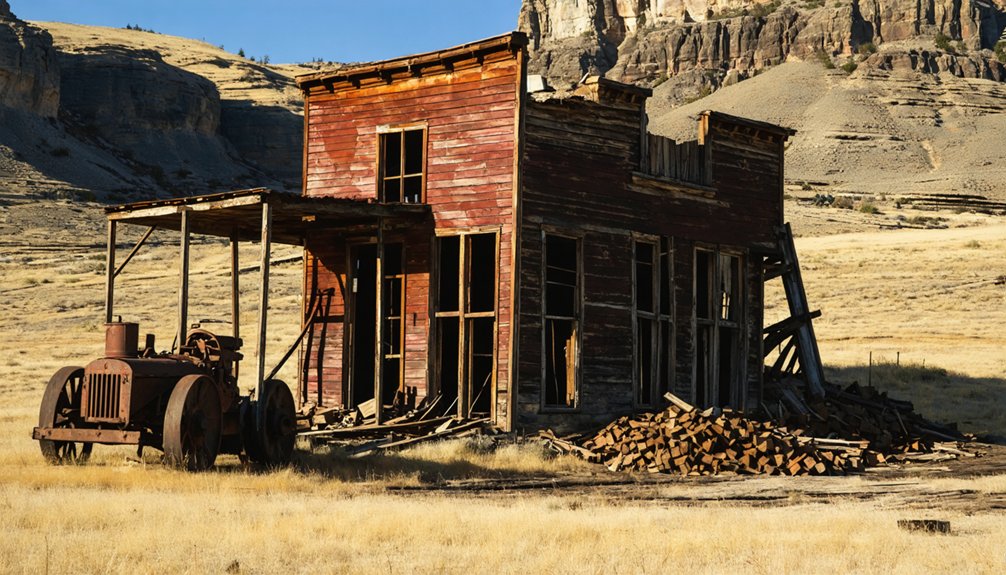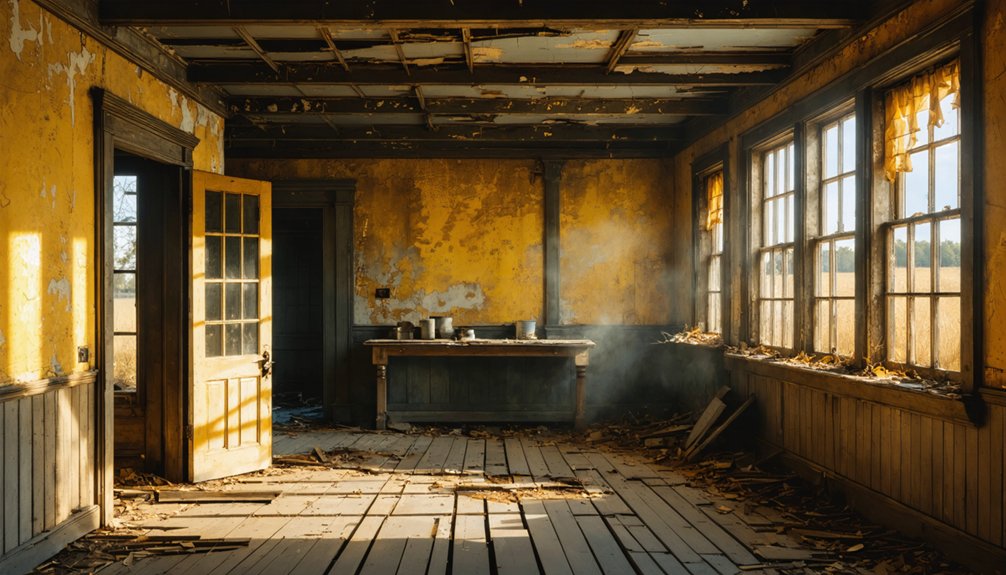You’ll find Newton City’s story begins with the 1874 Black Hills gold rush, when prospectors established claims near French Creek and Deadwood Creek. The settlement thrived through the 1870s with gold mining, sawmills, mercantile stores, and a chapel serving its growing population. After the sawmill’s closure in 1952, the town gradually declined as mining resources depleted and residents left. Today, the former boomtown has completely vanished, with only grasslands marking where this once-bustling community stood.
Key Takeaways
- Newton City was a Black Hills mining settlement established during the 1874 gold rush near French Creek and Deadwood Creek.
- The town’s economy centered around gold mining, sawmill operations, mercantile stores, and essential services like banking.
- Economic decline began with the sawmill’s closure in 1952, followed by mining depletion and railroad service termination.
- Today, no visible structures remain at Newton City’s location, with the area reverting completely to natural prairie grassland.
- The site lacks historical markers or tourist facilities, making it one of South Dakota’s fully disappeared ghost towns.
The Rise of a Black Hills Mining Settlement

When Custer’s 1874 expedition discovered gold in the Black Hills, it triggered a dramatic surge of prospecting activity that would reshape the region.
You’ll find that early prospectors initially focused on extracting placer gold near French Creek and Deadwood Creek, using simple mining technology to work these easily accessible deposits.
As the gold rush intensified through 1875, prospectors expanded their search toward Whitewood Creek, leading to the establishment of numerous mining settlements.
By April 1876, the discovery of the Homestake claim near present-day Lead marked a pivotal moment.
Mining operations evolved rapidly from basic placer mining to more sophisticated hard rock extraction methods, spurred by the establishment of the first stamp mill – the Jones and Pinney Mill – in December 1876.
The arrival of the Jones and Pinney Mill revolutionized Black Hills mining, advancing from simple placer techniques to industrial-scale extraction operations.
This technological advancement helped transform scattered mining camps into organized settlements across the Black Hills.
By 1880, miners had extracted between six to eight million dollars worth of placer gold primarily from the rich deposits of Deadwood Gulch.
Despite government efforts to enforce the 1868 treaty rights, thousands of unauthorized prospectors continued to pour into the region.
Daily Life and Economic Activities
As Newton City emerged as a bustling Black Hills mining settlement, daily life revolved around diverse economic activities and essential services.
You’d find gold miners working claims alongside sawmill operators processing lumber for construction and mine supports. The town’s economic backbone included mercantile stores, a bank, and boarding houses that served both single miners and families.
Community gatherings centered around the McCahan Memorial Chapel and the schoolhouse, where about 25 students attended classes. Like many ghost town hunting sites, traces of these gathering places remain visible today. Like Tinton, tin mining operations played a significant role in the area’s development.
You could catch the stagecoach three times weekly to connect with surrounding areas, though transportation shifts eventually saw trucks replacing rail service.
During tough times, especially the Depression, residents adapted through bartering and creative trading arrangements to keep the community functioning.
The Path to Abandonment
The decline of Newton City unfolded through a complex chain of economic and demographic challenges in the mid-20th century.
You’ll find the first major blow came with the closure of the local sawmill in 1952, which had been the town’s primary employer. Industrial decline accelerated as mining resources were depleted, and the unstable tin and gold markets forced companies to cease operations. Like many towns such as Ardmore, the lack of drinking water access severely impacted sustainability.
Population shifts became inevitable as the railroad’s departure in the 1980s severed crucial transportation links. Much like Okaton’s fate, the town’s railroad operations ceased by the end of the decade.
You’d have witnessed younger residents leaving for urban areas while aging populations remained behind. Environmental challenges, including frequent flooding and harsh winds, made it difficult to maintain structures.
What Remains Today
Today’s visitor to Newton City will find nothing but empty fields and grasslands where a once-vibrant community stood.
Unlike neighboring ghost towns that still maintain some structural remnants, Newton City has completely vanished into the South Dakota prairie.
The current landscape offers no visible evidence of its past existence, with the site now serving as open pasture land. This complete disappearance of civilization is characteristic of many abandoned settlement sites across the region.
Natural elements have erased all traces of the former town’s presence over time.
- No standing buildings or infrastructure remain on site
- The area has fully reverted to natural prairie conditions
- No roads or maintained pathways lead to the original location
- Archaeological findings are limited to possible underground foundations
- No tourist facilities or historical markers exist at the site
You won’t find preserved ruins or managed historical attractions here – the town has truly become a ghost, leaving behind only written records of its existence.
Historical Legacy in South Dakota Mining
Mining activity in South Dakota’s Black Hills forever changed America’s gold production landscape after the 1874 Custer Expedition sparked a massive gold rush.
The discovery of Black Hills gold in 1874 revolutionized American mining, launching an unprecedented rush that transformed both land and nation.
As you explore the region’s rich history, you’ll discover how mining techniques evolved from simple placer mining in creeks to sophisticated hard rock operations in places like the legendary Homestake Mine. The Holy Terror Mine became one of America’s richest gold producers during its peak years.
The rush brought thousands of fortune seekers, transforming wilderness into bustling communities. The Homestake Mine became a cornerstone of global gold production, generating 10% of world’s gold supply over its 125-year operation.
While some towns like Lead and Deadwood survived, others became ghost towns, standing as silent testimonies to the era’s boom-and-bust nature.
Today, this mining legacy lives on through preserved historical sites, the South Dakota School of Mines, and the Sanford Underground Research Facility.
The Black Hills’ mining heritage continues to shape the region’s identity, drawing visitors who seek to connect with America’s golden past.
Frequently Asked Questions
Were Any Famous Outlaws or Notable Historical Figures Associated With Newton City?
Like a dusty page torn from history’s book, you won’t find any outlaw legends or notable historical figures tied to Newton City – available records don’t connect it to any famous personalities.
What Indigenous Tribes Originally Inhabited the Land Where Newton City Stood?
You’ll find Woodland Indian cultures first inhabited the land around 300 B.C., followed by Dakota (Santee Sioux) tribes who dominated the region by the 1700s until Euro-American settlement forced their displacement.
Did Newton City Experience Any Major Natural Disasters During Its Existence?
Amidst the whispers of history, you won’t find any documented major natural disasters striking Newton City. Historical records from the Black Hills region don’t mention specific environmental catastrophes affecting this short-lived settlement.
What Happened to the Personal Belongings Left Behind by Departing Residents?
You’ll find those abandoned artifacts either deteriorated from natural elements, got scavenged by visitors, or ended up scattered across the region, leaving lost memories to fade into the landscape.
Were There Any Documented Paranormal Activities or Ghost Stories From Newton City?
Ever wonder why some ghost towns spark supernatural tales? You won’t find documented ghost sightings or haunted locations from Newton City – there’s no official record of paranormal activity from this vanished settlement.
References
- https://www.sdpb.org/rural-life-and-history/2023-08-21/some-black-hills-ghost-towns-and-their-origins
- https://www.sdhspress.com/journal/south-dakota-history-2-2/some-black-hills-ghost-towns-and-their-origins/vol-02-no-2-some-black-hills-ghost-towns-and-their-origins.pdf
- https://www.youtube.com/watch?v=_0WNYsFLSLA
- https://icatchshadows.com/okaton-and-cottonwood-a-photographic-visit-to-two-south-dakota-ghost-towns/
- https://en.wikipedia.org/wiki/Hill_City
- https://www.historynet.com/ghost-towns-mystic-south-dakota/
- https://en.wikipedia.org/wiki/List_of_ghost_towns_in_South_Dakota
- https://ruralresurrection.com/ghost-towns-mystic-south-dakota/
- https://www.tripadvisor.com/ShowUserReviews-g54645-d629516-r973800455-Newton_Fork_Ranch-Hill_City_South_Dakota.html
- https://blackhillsminingmuseum.com/learn/history



